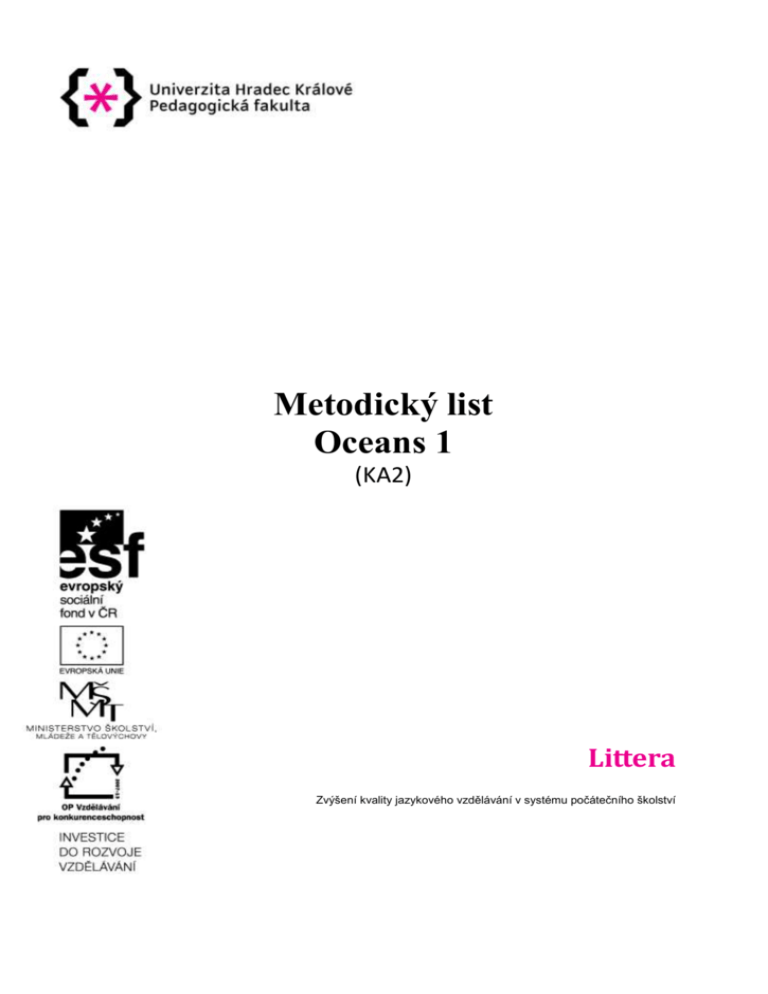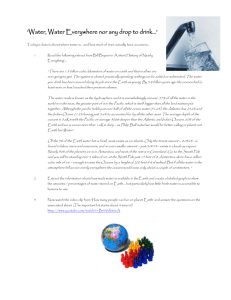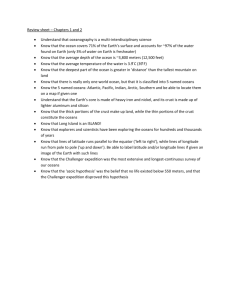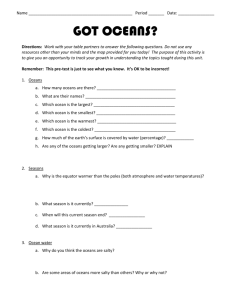GEOGRAPHY
advertisement

Metodický list Oceans 1 (KA2) Littera Zvýšení kvality jazykového vzdělávání v systému počátečního školství Oceans of the World There are five oceans, and they cover about 70 % of Earth. Oceans and their seashores are different all around the world. On the Arctic Ocean and the Southern Ocean there´s a lot of ice in winter. In warm tropical oceans you can find colourful coral reefs, where very many plants, fish and other animals live. An ocean is always moving because of waves, currents, and tides. When the wind blows over the water, it makes waves. Currents are large amounts of warm or cold water that move around the ocean. An ocean also moves up the seashore and back again two times a day. These movements are called tides. Icy Oceans Large parts of the Arctic Ocean and Southern Ocean have ice on them in winter. There are also big icebergs. In summer, a lot of the ice melts. Then there are little pieces of ice in the oceans, and the icebergs are smaller. Polar bears live in the Arctic. Most of the year, they live on ice. They catch seals from holes in the ice. They also swim between the ice and icebergs. Polar bears are the biggest type of bear, but their cubs are very, very small when they are born. In summer, the Southern Ocean has a lot of plankton. Many dolphins, whales, seals, and birds come there to feed. Penguins live near the South Pole. They dive into the ocean for fish and other small animals. They have special feathers that keep them warm and dry. Their feathers are so warm that penguins can sometimes get too hot! Oceans in Danger There are many dangers for ocean birds and other animals. Big boats carry oil across the oceans. If the oil goes into the water, birds and other animals eat it. It also gets on their skin or feathers. It can kill them. Dirty water and chemicals from toilets, factories, and farms also go into the oceans. They can kill plants, fish, and other animals. People leave things on the beach, too, and sometimes these things can hurt animals. Sea turtles eat plastic bags because when they are in the water they look like jellyfish. Sometimes, big fishing nets catch dolphins, sea turtles, seals, and birds. Coral reefs are not safe either because they need clean water. Boats can break them, too. So now we need to keep the ocean clean and safe. There are new rules so people can´t take too many fish from the ocean. There are also new types of fishing net. Big animals can swim out of these nets. Now there are also some marine parks – special places where the ocean is always clean and safe. BLADON, Rachel: All about Ocean Life. OUP, 2010. Pre-reading Task 1 How many oceans are there and which continents do they wash? Can you name any typical animals for each of the oceans? Pre-reading Task 2 How much do you know about the oceans? Test yourself. 1. What ocean has the most coral reefs? a) Indian b) Atlantic c) Pacific d) Arctic 2. What ocean is the biggest? a) Atlantic b) Pacific c) Indian d) Arctic 3. Where is the deepest point on Earth? a) Atlantic b) Pacific c) Indian d) Arctic 4. What is the largest fish in the sea? a) monkfish b) mola (sunfish) c) whale shark d) blue whale 5. What is the smallest ocean? a) Pacific b) Arctic c) Indian d) Atlantic Post-reading Task 3 Match the following items: Dirty water Boats Oil Clean and safe Plastic bags Dolphins Fishing nets Toilets Marine parks Turtles Post-reading Task 4 Are these statements true or false? 1. Currents are big animals living in the oceans. 2. Coral reefs can be found in the Arctic Ocean. 3. Polar bears feed on seals. 4. Tides occur twice a day. 5. Polar bears have the biggest cubs. 6. New types of fishing net need to be invented so that the big animals can swim out of them. 7. Penguins eat fish and plankton. 8. The Southern Ocean is a cold one.








